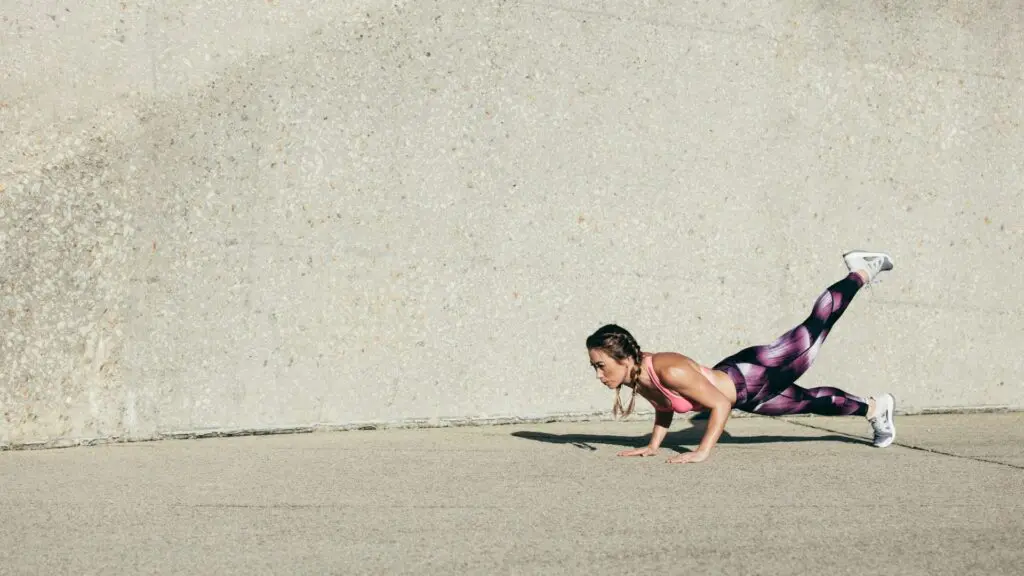
5 Core Strengthening Exercises To Fix Your Low Back Pain For Good
Lower back pain nearly always comes with an issue with the core strength and control. Your low back has become injured because you’ve not got good activation of your core, it does not protect your spine and so an injury that should have been avoided or recovered from quickly, lingers.
If you’ve had low back pain for any length of time, you’ve probably started to do core exercises at some point but people often turn to the wrong sorts of core exercises, or don’t think of the core in the right way and this is why they fail to rebuild low back, core and spinal strength. Therefore the back pain keeps coming back. Today we want to give you a step by step for some simple core strengthening exercises that you can do at home and in the gym, to build your core safely.
You’ll master the simple skill of engaging the core fist, then apply that skill to a more challenging movement, from there we’ll start to build an ability to progressively challenge your core for the long term with 3 Core exercises you’ve probably not thought of as core exercises before!
One secret to a strong core after a back injury
The one thing you have to know if you’ve injured your lower back is that your spinal position matters and you must learn to stabilize your spine into a neutral position. This is by far the safest and most effective way for you to rehabilitate your spine in the short to medium term. It will result in long term healing and rebuilding that gets you back doing the things you want to, be that playing with the grandchildren on the floor or working out in the gym with friends.
The exercises you must do to rebuild your core after back pain
Each of these exercises is going to follow the one secret of a neutral spine just mentioned so make sure that there are no bad movements like “pelvic tucks” or “pelvic tilts” that creep into these at all! The first two exercises are on the floor and if need be, you can use a small rolled towel to support the natural position of the spine to help you keep everything still as you’re learning.
Exercise One: Magic Candle Drill For Core Activation
This drill is a fantastic one that will help you learn what you should feel as you activate your core. It is a hack for those of you who struggle to feel the lower core working. By using your out-breath. Completely emptying the lungs, then trying to empty them more, you force your body to recruit your deep core muscles, the ones that stabilise your spine.
Step-by-step: The Magic Candle Drill For Core Activation
- Lie on your back on the bed or on the floor with your knees bent
- Place a small rolled towel, only an inch or so in diameter to support your low back arch
- Place your hands on your waist, your fingers should be either side of your belly button
- Take a deep belly breath in
- Your spine should not move
- Breathe out slowly, and keep breathing out all the way
- Once you feel like you have no more air to breathe out…
- Imagine you have a magic candle that you’re trying to blow out
- Without taking another breath in, try and blow that candle out with a short sharp breath
- Try 2 or three attempts to blow out the candle
- Then repeat the exercise
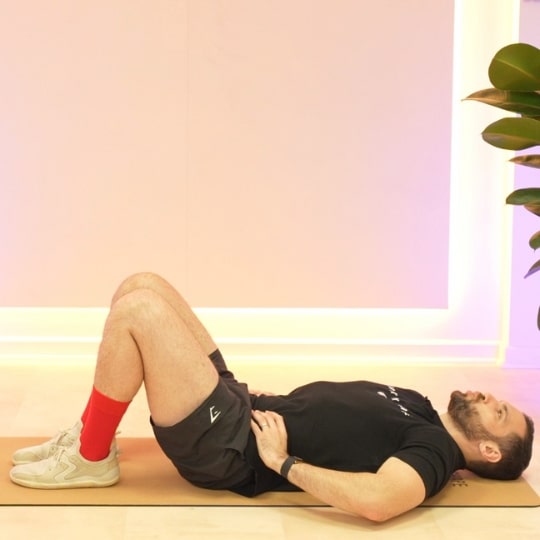
This exercise is the best place to start because it quickly enables you to “feel it” even if you’ve struggled to feel your core before. For more information on this activation for your core check out the latest video on the magic candle drill for your core activation, it’s perfect for beginners!
Begin by doing sets of 5 to 10 repetitions focusing on the tight engagement in the lower abs, below your belly button. Seeing as this is a “drill” you can do this multiple times a day so you learn to do it faster!
Exercise Two: Simplified Deadbug Exercise For Your Core Strength
This next exercise will help you build your strength in the core after you’ve learned to activate it properly. Too many people simply follow the movements of this exercise without proper engagement of their core and therefore this great core exercise turns into a leg wiggling dance instead. We want to make sure that the core is engaged properly so you benefit from building strength, in the lower part of the core, the part that is responsible for stabilising your lower lumbar spine, where most of the back injuries and degeneration occur first.
Step-by-step: The simplified deadbug exercise for your core strength
- Lie on your back on the floor or bed if you cannot get onto the floor easily
- Place your hands on your abdomen with your fingers pressed into your tummy
- Tighten your core focusing the tightness to your lower core in particular
- Bring up one leg at a time so your hips and knees are at 90 degrees
- Your pelvis should not rock here and your spine should stay still if you’ve engaged well
- Now slowly straighten one leg out all the way down
- Your heel should hover about 1 inch off the floor
- Then return to the top position with the hip and knee at 90 degrees
- Repeat for the other leg
- When finished doing your repetitions ALWAYS lower one leg at a time.
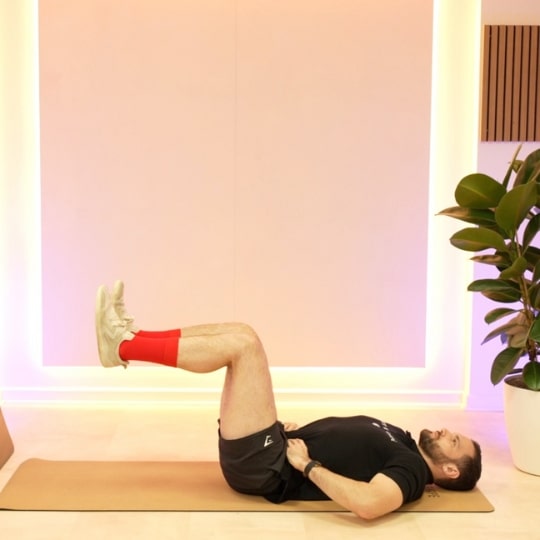
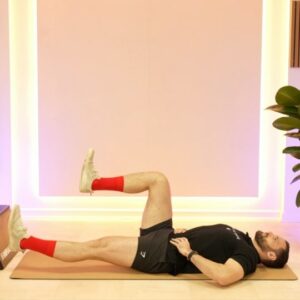
This exercise takes the skill of engaging the core muscles and begins to challenge it, meaning that as your legs come up, your core is under pressure to hold your spine steady, in the beginning your tummy might relax or lift up towards the sky as you lift the legs up. Practice holding it tight and stopping this. As your legs go out, you will start to feel again like your tummy wants to lift towards the sky – CONTROL THIS. This is where the challenge in this exercise is as your legs pull on your core, the “exercise” is working. Your job is to be able to hold your core, tummy and spine DEAD STILL through the full exercise. Over time you’ll find you do this better and better as your core gets stronger.
Aim for 10 reps of this exercise, have a break for 30 to 60 seconds and then repeat for 3, 4 or 5 times. As you get stronger this will become more and more manageable. You should work hard in one go and only do this exercise once per day. If you feel you can do more, work harder in the one “workout” rather than working out a second time later in the day.
The big mistake people make with core exercises that makes their back weak
One of the most common errors that people make when strengthening their core is that they stick to exercises like the first two that we have covered. While these “core exercises” are commonly understood to be “core exercises” they only work the core musculature in one way and fail to work other aspects of the core that are vitally important. You should take care to avoid this mistake as doing so will leave you with a “strong core” but a “weak back”.
The next exercises, as you will see complete the core strengthening process, you will do them for months, years and even decades to build your core strength, protect your back and keep it strong for the long term. Again, we’re focusing on a neutral spine, but now we are upright in the “real world”.
Before you say it, if you think your back is too weak for these exercises, ask yourself if you’ve done these three things in the last 24 hours, if the answer is YES, then get working on them NOW, your low back health depends on it.
The three things you have been doing in the last 24 hours:
- Did you get up or sit down on the toilet, a chair or the bed?
- Did you wash your face, wash your hands or brush your teeth?
- Did you go upstairs in your house, or up a curb or step out on the street?
- Did you get dressed?
We can say with almost certainty that you’ve done all of those activities already, even with a weak or injured back, so getting started RIGHT NOW working to learn how to do these movements safely is your top priority.
Exercise three: Your back friendly squat
The squat exercise spells fear for some with back pain, only to see in consultations the person get up and down numerous times without thinking about it, in spite of the pain in many cases. This is often done with bad technique. We recently went into detail on this one exercise that you should master before retirement, so you can check that video out if you have time. That being said, learning the squat is so important for your core as you cannot do a good squat without core engagement, and as you progress over time, your squat will be one of the best ways to challenge your core. Without a strong core on the squat, your body will simply bend, round, and tip over!
Step-by-step: A simple squat exercises
- Start with your feet shoulder width apart
- Your toes slightly turned out
- Your knees point the same direction as your toes
- Engage your core and stand with good posture
- Bend your hips and knees pushing your bum back into a sitting position
- Lower slowly until you feel your back wants to round or move
- Stop before this happens, and return to standing upright

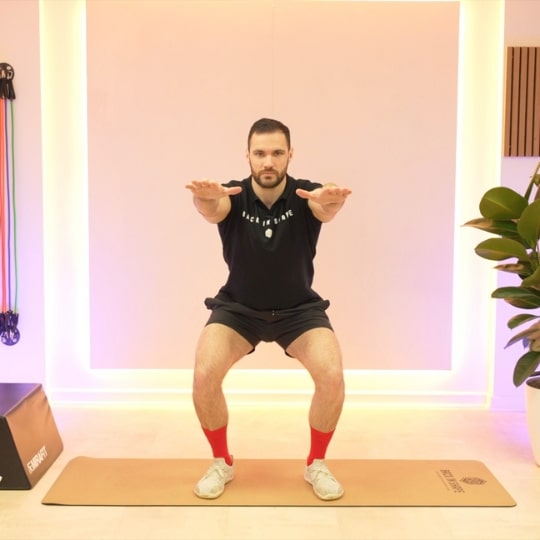
As you lower your body down, you will find that your core begins to work harder and harder to prevent your legs from pulling your lower back into a curled position. You must learn to become “aware” of this tension building so you maintain neutral in your spine and know when to stop the movement. With time, as your core gets stronger and more coordinated, you will find you can do more and more movement successfully and safely.
Start with 10 reps, like before and repeat this with your bodyweight for 3, 4 or 5 sets with 30 to 60 seconds rest between each set, done once per day! Check out the section towards the end of this exercise on how you can build strength over the long term using these exercises to make sure you build strength in your low back and core for the long term.
Exercise four: The essential hip hinge you need to learn
The ability to hip hinge ties into the correct squat previously mentioned. This is a vital skill because it will put in place habits that you bend with the hips first instead of the low back. Getting competent and then stronger with this movement will provide you with the foundation of a strong core and low back so take the time to learn this movement well.
Step-by-step: how to hip hinge
- Start standing with good posture, feet shoulder width apart.
- Toes and knees should be turned out ever so slightly.
- Keep your spine still as if all the joints are fused and your core tight
- Push your bum back and pivot at the hip joint
- Lower until you feel the back of your thighs go tight
- When you can go no lower return to the top

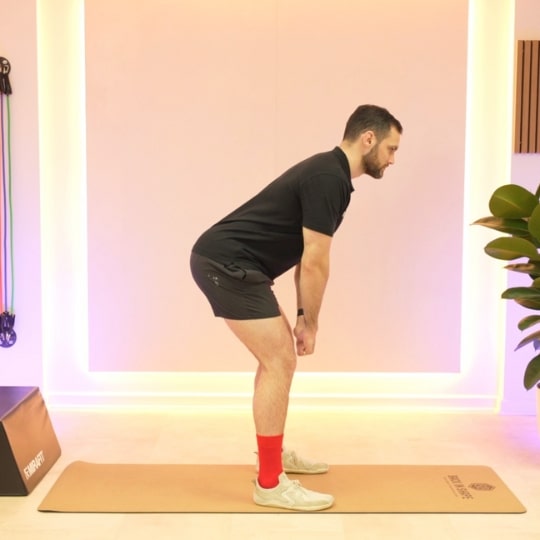
This movement is the perfect compliment for the squat and allows you to build a good habit for good spinal health. Over time the squat and the hip hinge will become subconscious for you, whenever you do those activities mentioned earlier, sitting, washing your face, etc, you will move properly instead of bending your back like a fishing rod!
Start with 10 reps, like before and repeat this with your bodyweight for 3, 4 or 5 sets with 30 to 60 seconds rest between each set, done once per day! Check out the section towards the end of this exercise on how you can build strength over the long term using these exercises to make sure you build strength in your low back and core for the long term.
Exercise five: the split squat for balance and strength
This is the final step, adding a little more in the way of balance and coordination to the work. This split squat focuses the movement on one side of the body forcing your core to stabilise properly, keeping your spine in line and generating movement from your hips and thighs. This will be a challenge to begin with but with time and careful application of technique focusing on keeping your knees stable, and your back in control this will be an invaluable process to complete the strengthening of your core completely.
Step-by-step: the split squat for core strength, balance and spine stability
- Stand in front of a chair, sofa or exercise bench
- Stride forwards 1-2 feet, and place your back foot to rest onto the chair
- Point your toes so the back foot and leg is supported comfortably
- You will be in a “lunge position” with your back leg elevated
- Now slowly lower your weight on the front leg by bending the knees and hips
- Lower yourself as low as you can without your knee or back wobbling
- Return to the upright positon.
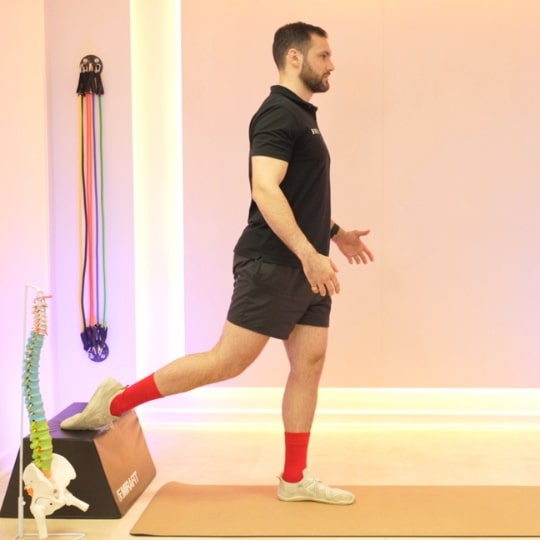

This exercise will require some balance and you will get better at it quite quickly, if you’re unsure, you can always do it near a wall or chair for support. Make sure that your hip does not “drop” on the one side, bending your spine. This is a common mistake which means you’ve not used your “core” to keep your spine still and neutral. With practice you will get better, and stronger!
Start with 10 reps on one leg, then the other leg. Like before and repeat this with your bodyweight for 3, 4 or 5 sets with 30 to 60 seconds rest between each set, done once per day! Check out the section towards the end of this exercise on how you can build strength over the long term using these exercises to make sure you build strength in your low back and core for the long term.
What makes the last three exercise the BEST core strengthening exercises
The simple truth is that you can do deadbugs, or other “core exercises” you might have done before, planks, side planks, leg raises and the like until you’re blue in the face. These are common and done in pilates classes or with your physiotherapist. They just build a strong-ish core, but leave a weak back.
Why?
Because there is no load!
The last three exercises (especially exercise 3 and 4) are done after you have a hip or back surgery, why? Because they need to know you can get around at home before they discharge you from the hospital. I say this to say, they’re safe when done well, and are FOUNDATIONAL! They are also done by elite power lifters with 100’s of pounds on their back.
Who do you think has a stronger back, the power lifter who can lift 100kg, 300kg or more on a squat, or the pilates student who can do 100 leg raises. It is obvious the forces are not even in the same postal code!
There is the point.
A squat, hip hinge or split squat with a 10lb, 25lb or 100lb weight is ALWAYS going to challenge your core in the most complete way, not only the core muscles, but your spine as well, they actually make your spine stronger – when done properly. Avoiding them will make your spine weaker and this is not good.
Building a strong core and a healthy back for the long term
Ultimately it is the careful and steady application of these exercises with more and more load over the long term that builds a strong core and a healthy back. You must learn good technique to be safe, and keep good technique as you progress. If you do this right you will build a truly strong core, as we see our members and patients doing over the years. Even those with terrible back pain, who’ve had injections or spinal surgery! It is not a quick fix, but it is a good fix, and a lasting one!
If you want a little more guidance to help you with these exercises, then check out the 80 minute back health masterclass where we walk you through the process with live demonstrations and tips, it’s freely available. And don’t forget, you always have the membership to the Back In Shape Program, the best way we can help you fix your back pain from home with expert support from our team. Use the link below to learn a little more and join the community today.









Responses